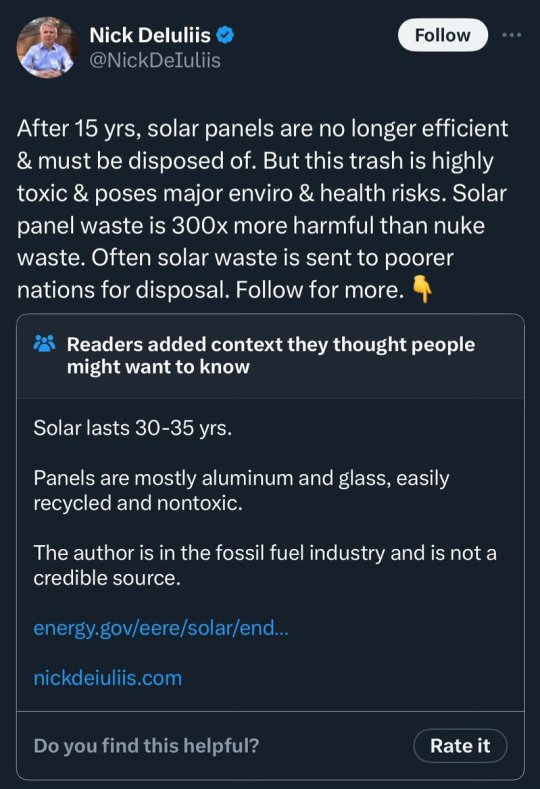#solar panels
Text
"Cody Two Bears, a member of the Sioux tribe in North Dakota, founded Indigenized Energy, a native-led energy company with a unique mission — installing solar farms for tribal nations in the United States.
This initiative arises from the historical reliance of Native Americans on the U.S. government for power, a paradigm that is gradually shifting.
The spark for Two Bears' vision ignited during the Standing Rock protests in 2016, where he witnessed the arrest of a fellow protester during efforts to prevent the construction of the Dakota Access Pipeline on sacred tribal land.
Disturbed by the status quo, Two Bears decided to channel his activism into action and create tangible change.
His company, Indigenized Energy, addresses a critical issue faced by many reservations: poverty and lack of access to basic power.
Reservations are among the poorest communities in the country, and in some, like the Navajo Nation, many homes lack electricity.
Even in regions where the land has been exploited for coal and uranium, residents face obstacles to accessing power.
Renewable energy, specifically solar power, is a beacon of hope for tribes seeking to overcome these challenges.
Not only does it present an environmentally sustainable option, but it has become the most cost-effective form of energy globally, thanks in part to incentives like the Inflation Reduction Act of 2022.
Tribal nations can receive tax subsidies of up to 30% for solar and wind farms, along with grants for electrification, climate resiliency, and energy generation.
And Indigenized Energy is not focused solely on installing solar farms — it also emphasizes community empowerment through education and skill development.
In collaboration with organizations like Red Cloud Renewable, efforts are underway to train Indigenous tribal members for jobs in the renewable energy sector.
The program provides free training to individuals, with a focus on solar installation skills.
Graduates, ranging from late teens to late 50s, receive pre-apprenticeship certification, and the organization is planning to launch additional programs to support graduates with career services such as resume building and interview coaching...
The adoption of solar power by Native communities signifies progress toward sustainable development, cultural preservation, and economic self-determination, contributing to a more equitable and environmentally conscious future.
These initiatives are part of a broader movement toward "energy sovereignty," wherein tribes strive to have control over their own power sources.
This movement represents not only an economic opportunity and a source of jobs for these communities but also a means of reclaiming control over their land and resources, signifying a departure from historical exploitation and an embrace of sustainable practices deeply rooted in Indigenous cultures."
-via Good Good Good, December 10, 2023
#indigenous#native americans#first nations#indigenous rights#tribal sovereignty#solar energy#solar power#solar panels#renewable energy#green energy#sioux#sioux nation#sustainability#climate hope#electrification#united states#hope#good news
2K notes
·
View notes
Text
1K notes
·
View notes
Photo

Invisible Solar
Invisible Solar is a new PV technology that take on the appearance of any building material. Each Invisible Solar module is more than a photovoltaic panel, it also is an active architectural element with various functionality.
Disguising solar panels as ancient Roman tiles in Pompeii

"They look exactly like the terracotta tiles used by the Romans, but they produce the electricity that we need to light the frescoes," says Gabriel Zuchtriegel, Director of the Archaeological Park of Pompeii. This solution is part of a more comprehensive strategy to turn costs into savings opportunities and to embrace sustainable development.
Technically called "traditional PV tiles", the invisible solar panels used in Pompeii come from Camisano Vicentino, a little Italian town with slightly more than 10 000 inhabitants, halfway between Padua and Vicenza. They were created and patented by the family business Dyaqua.

How They Work

Operating of Invisible Solar modules is based on the low molecular density. Each module is composed of a non-toxic and recyclable polymeric compound we properly developed to encourage the photon absorption.
Inside the module there are incorporated standard monocrystalline silicon cells. The surface, that is opaque at the sight but translucent to sun rays, allows the light to enter and feed the cells.

Oh my goodness.
Solar voltaic’s designed for historic contexts that offers architectural and aesthetic integration?
AND they are already installed in Pompeii and not marketing vapourware?
AND they are made by a small Italian family business?
Be still my beating solarpunk heart 🥰 ☀️
via @stml in a forum.
#solarpunk#solar punk#solar power#voltaics#solar panels#terracotta#pompeii#renewables#solar energy#Aesthetic#Architecture
3K notes
·
View notes
Text
I really hope they can work the bugs out of this solution, because if it's done right, it'll really be a win-win situation. Less evaporation of water, and solar power being generated every day? Yes, please. We are smart, resourceful beings, and this is far from the most difficult problem we've had to address.
This is also a great example of how we can go back and fix mistakes of the past. We very, very rarely ever come up with technological solutions that take long-term effects on the environment into consideration, and so the way many things are designed often leads to some sort of damage, whether through manufacture, use, disposal, or all of the above. Retrofitting canals (which have been used in agriculture for thousands of years) will have benefits not only in the ways mentioned above, but also gets people thinking more about the impacts we make.
I'm hoping that this will lead to more new technology being developed in ways that already anticipate and account for negative impacts so that they avoid them in the first place, rather than having to engineer new solution many years down the line.
#solar power#solar panels#renewable energy#water#environment#irrigation#agriculture#green energy#conservation#technology#clean energy#science#solarpunk#hopepunk
686 notes
·
View notes
Text


Atlantica Solana Generating Station - Arizona - USA
🌎
4K links : 1 & 2
#4k#wallpaper#google earth#satellite view#aerial photography#solar panels#power station#arizona#solana#usa#lines#geometry#abstract#texture#pattern#grid#atlas#landscape#desert#industrial#electricity#dji
497 notes
·
View notes
Text
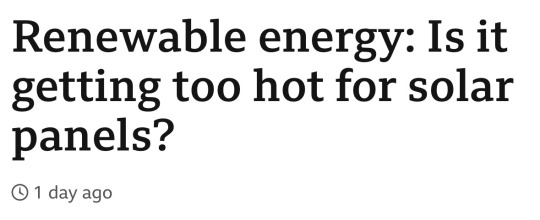

Source

#capitalism#government#solar energy#solar panels#solar power#renewable electricity#climate change#news#current events#the left#ban fossil fuels#green energy#green new deal
913 notes
·
View notes
Text
In France, all new and existing medium to large parking lots will have to be covered by solar panels

In France, solar just got a huge boost from new legislation approved through the Senate this week that requires all parking lots with spaces for at least 80 vehicles – both existing and new – be covered by solar panels.
Starting July 1, 2023, smaller carparks that have between 80 and 400 spaces will have five years to be in compliance with the new measures. Carparks with more than 400 spaces have a shorter timeline: They will need to comply with the new measures within three years of this date, and at least half of the surface area of the parking lot will need to be covered in solar panels.

Other measures on the table include building large solar farms on vacant land found alongside highways and railways, as well as on agricultural lands where feasible.
France’s national rail service SNCF also plans to install some 190,000 square meters of solar panels in 156 stations throughout the country by 2025 and 1.1 million square meters by 2030, all with the aim to reduce energy consumption by 25%.

The government also plans to build around 50 additional wind farms likes the one offshore Saint-Nazaire by 2050 in France. Measures are in place to reduce delays in building offshore wind farms from 10-12 years down to six years, and large solar farms from six years to three years.
(Source: Electrek, November 8th 2022)
2K notes
·
View notes
Link
Still in the early stages, but this is a huge breakthrough!
“In 2017, scientists at a Swedish university created an energy system that makes it possible to capture and store solar energy for up to 18 years, releasing it as heat when needed.
Now the researchers have succeeded in getting the system to produce electricity by connecting it to a thermoelectric generator. Though still in its early stages, the concept developed at Chalmers University of Technology in Gothenberg could pave the way for self-charging electronics that use stored solar energy on demand.
“This is a radically new way of generating electricity from solar energy. It means that we can use solar energy to produce electricity regardless of weather, time of day, season, or geographical location,” explains research leader Kasper Moth-Poulsen, Professor at the Department of Chemistry and Chemical Engineering at Chalmers.”
#technology#sustainable power#sustainable energy#green energy#solar energy#solar battery#hope#good news#climate change#global warming#renewable energy#solar panels
4K notes
·
View notes
Text

The disappearing sun. 🌞🌖🌗🌘🌑(mixed media on paper)☀️
#solar#solar power#sunny#sun#sunset#sunrise#sunshine#sun rays#solar panels#soleil#sol#eclipse#eclipse 2024#solar eclipse#solar eclipse 2024#solar system#cosmos#sun and moon show#sun and moon#pop art#naive art#basquiat#jean michel basquiat#art brut#childrens book illustration#andy warhol#keith haring#neo expressionism#abstract expressionism#kids art
137 notes
·
View notes
Text
🗑️🗑️🗑️
#solar panels#scam#warning#clean energy#hoax#green energy disasters#corruption#liars#con artists#deep state’s plan to destroy our planet and humanity must be defeated#united we stand#divided we fall#speak up#standup#fight for justice#speaktruth#these people are evil#truth#please share#wwg1wga
191 notes
·
View notes
Text
Countries That Generate 100% Renewable Energy Electricity
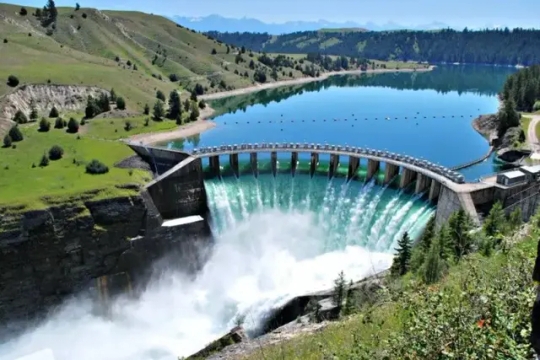
Pictured: Hydropower is the most widely used source of renewable energy-generated electricity. This dam is located near Polson, Montana.
Is 100% Renewable Resource-Generated Electricity Possible?
"With concerns growing regarding burning fossil fuels and their connection to global warming, a great debate is occurring regarding the feasibility of producing electricity entirely from non-carbon emitting green renewable energy sources such as geothermal, hydroelectric, wind, and solar. Skeptics and naysayers claim that achieving such a goal is impractical, would destroy the economy, and is in the realm of pie-in-the-sky thinking.
But is it actually impractical and unattainable? The answer is clearly "no" since there are already several countries that generate 100% of the electricity they use from renewable sources of energy. There are also many other countries that obtain over 90% of the electricity they use from renewable energy sources. Despite the negative rhetoric by some, there’s nothing impractical about using renewable energy to generate electricity on a grand scale.
The Countries Leading the Way to a 100% Renewable Energy Electricity Future
The following is a list of countries that are leading the world into the new frontier of economies that run their electrical grids either entirely or nearly entirely on renewable energy per a 2018 report by the International Renewable Energy Association (IREA) and the U.S. Energy Information Administration (EIA) statistics. This list and the percentages are subject to change over time, but it provides a good snapshot of just how practical renewable energy currently is for electricity generation.
Iceland obtains 100% of the electricity it needs from renewable energy sources. Iceland is somewhat unique since volcanic activity on the island provides a significant geothermal energy source that is utilized to provide approximately one-quarter of the country’s electricity. The remaining three quarters are provided by hydro-power.
Paraguay obtains 100% of the electricity it uses from renewable sources. Huge hydropower dams provide all of Paraguay's electricity needs, as well as supply neighboring Argentina and Brazil with electricity.
Costa Rica is another country leading the way towards 100% renewable-produced electricity. During 2018, Costa Rica met all of its electricity needs using renewable energy sources such as hydro-power, geothermal, biomass, wind, and solar for 300 days in a row.
Ethiopia, Kenya, Namibia, Norway, Tajikistan, and Uruguay are countries currently generating greater than 90% of the electricity they use from renewable energy sources. Some of these countries are working towards running their electric networks entirely from renewable energy.
Some things stand out from the list of countries leading the way in electricity generated from renewable energy.
They are relatively small countries.
They have abundant renewable natural resources, particularly abundant water resources available to generate hydro-power.
The list includes both wealthy developed and poor developing countries.
The fact that both developed wealthy countries and poor developing countries are leaders in renewable energy-produced electricity indicates that the cost of constructing renewable energy resources is not a limiting factor. In fact, developing countries can justify the capital cost of building renewable energy sources of electricity due to the fact that the operating costs are relatively low and predictable (not subject to commodity price swings), and renewable energy allows a country to be self-sufficient in meeting its electricity needs.
Large Developed Countries Can Also Produce 100% Of Their Electricity From Renewable Energy
Critics and naysayers might say that while these achievements by small countries are impressive, implementing renewable energy on a large scale is impractical for larger developed countries. But is it really impractical?
Cost and technological barriers are not what they once were for renewable energy. In fact, costs for renewable energy continue to decline year after year, and renewable energy technologies continue to develop and become more efficient. Many countries have not even come close to tapping their renewable energy potential or even tried some of the technologies available, such as electricity generated by wave or tidal power. Additionally, the argument that renewable energy is only useful when it is being generated is becoming irrelevant since large utility-scale batteries are now available that have the capability to store electricity generated by renewable energy and allow it to be used when needed.
Clearly, the answer is yes. Large developed countries can produce 100% of the electricity they need from renewable sources. It is only a matter of the will and investment at this point to make the changeover from fossil fuel-generated electricity to renewable energy electricity generation. The technical barriers are not as great as naysayers claim, as proven by smaller countries that have already reached the 100% threshold. Moving towards 100% renewable energy sources of electricity will become easier over time as wind, solar, and other renewables become more efficient and large utility-scale battery storage technologies become capable of storing larger quantities of energy for use when needed.
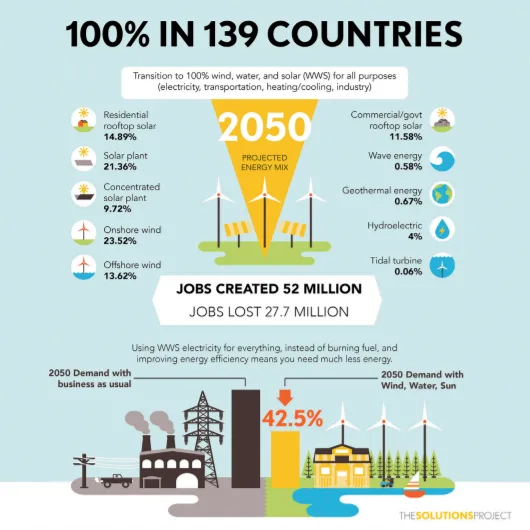
Pictured: Researchers lay out a plan for nearly 140 countries that could be powered 100 percent by renewable energy by 2050. spectrum.ieee.org
The City of Los Angeles Leads the Way in the U.S. With Inexpensive Solar
Various forms of renewable energy have experienced significant cost reductions to a point at which they are competitive and, in some cases, cheaper than traditional electrical energy sources such as coal, oil, and natural gas. This cost reduction trend will accelerate the change over to renewable sources of electricity. For example, the City of Los Angeles signed a deal in July 2019 for a large solar electricity array that will provide 7% of the city's electricity by 2025 at only two cents per kilowatt-hour (kWh). This is far cheaper than fossil fuel-derived electricity.
In addition to being cost-competitive, the practicality and reliability of renewable energy are poised to make major advances as large utility-scale battery technologies are rolled out that can be used to capture renewable energy when it is created, so the electricity can be used at a later time when needed. The Los Angeles solar array project includes utility-scale battery backup at a cost of 1.3 cents per kWh, so the electricity generated by the sun will be available even when the sun is not shining.
Los Angeles has a goal of achieving 100% renewable electricity generation by 2050. This solar contract is a big step toward achieving their goal."
-via TurboFuture, February 21, 2023
#renewables#renewablefuture#renewable energy#clean energy#green energy#solar power#solar panels#fossil fuels#climate crisis#climate change#global warming#hydropower#geothermal#wind power#wind turbines#iceland#paraguay#costa rica#ethiopia#kenya#namibia#norway#tajikistan#uruguay#united states#los angeles#battery#hope posting#hopepunk#sustainability
315 notes
·
View notes
Text
Solar Powered Community Fridges - Concept Art
So one of my grad school classes is a 8 week long group project to essentially come up with an artistic solution to a problem. Of course, my pitch was solarpunk in nature, and my group actually really liked it! Basically, the concept is to design a series of solar panel-powered community fridges, to help address food insecurity and build community in different areas without having to rely on a specific host building to provide power. What better time to show my concept art than Solarpunk Aesthetic Week?
Originally, I was just drawing up ideas with what usually comes to mind when I imagine fridges--upright fridges. Here's my concept art!

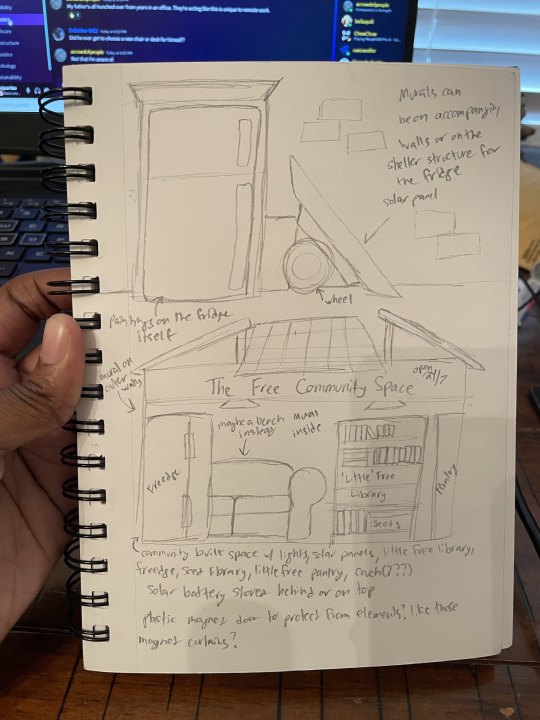

In these sketches, my main concern was imagining how these fridges would fit into the community alongside their power sources--I didn't want them to be too bulky, but I also wanted them to be available for easy access. I also figured they'd need shelter for the fridge's longevity, as well as to protect any users from the element. It'd also be nice to have them alongside other mutual aid sources like little free pantries, little free libraries, the like. One of my favorite designs is the sheltered community space on page 2, with the fridge, the seat, the pantry, and the library all in one protected structure with solar panels on the top. Having a table near the community fridge would also be nice to give people a place to rest as well.
However, around this time, I started trying to find out just how big of a solar panel would be needed to power a fridge like this, and the results were... a bit discouraging. Until! I was informed that chest freezers use way less energy to keep cool--cool air sinks, so opening an upright fridge releases most of the cold air that's been building up and makes the machine work harder to keep cool, whereas a chest fridge doesn't lose nearly as much cold air. In addition, some people have converted chest freezers into chest refrigerators for as little as ~$30 USD. Due to the insulation in a chest freezer, converted chest fridges use way less energy than their upright counterparts to keep cool, making it way more feasible to power them with solar.
So of course, I had to get to drawing again!
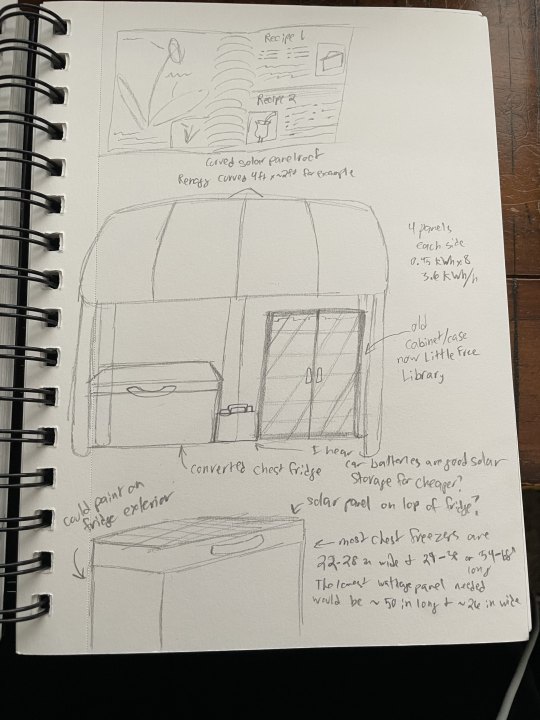
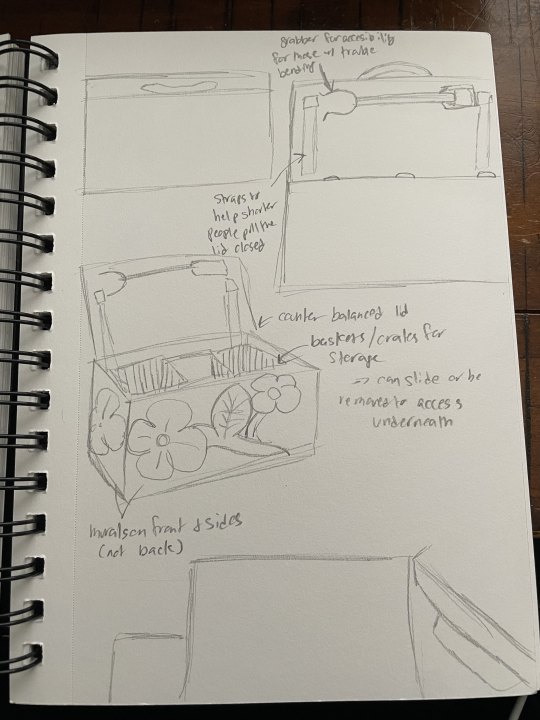
Since I'd already concepted a variety of structures for upright fridges, for the chest fridges I mostly focused on their design and possible convenience/accessibility concerns I had been worried about, one of the main being having to reach inside vertically instead of horizontally--several of my family members have difficulty bending, so I was worried having a chest fridge would make things more difficult for others like them. There are likely other ways to address this concern that I haven't thought of, but for now I've concepted putting a grabber tool inside of every fridge so people with trouble bending can still get things. How well it'd work in reality, I'm not sure...
Buuut these are my concepts so far! I hope you like them, I hope they're cool? Let me know what you think! I think these would be cool to have in a solarpunk future--whether they're entirely possible today or will have to wait until a somewhat-distant, 'solar panels can generate more energy with less size and fridges are also way more energy efficient' future I can't say, but it's cool to think about!
[Image 1: Pencil sketches of refrigerators connected to solar power. The annotations on them are as follows. An arrow points to a magnet caddy on the freezer door with markers and stickers, saying "Markers + labels for dating donations". An arrow points to a battery-structure at the base of a solar panel system saying "Doubles as charging station for phones & stuff". An arrow points to a slanted roof structure over a fridge saying "Bus stop-esque structure." An arrow points at a glass door grocery store-style fridge saying "any kind of fridge, any size."
Image 2: Pencil sketches of refrigerators connected to solar power. The annotations on them are as follows. An arrow points to a fridge under a slanted roof structure, saying "Paintings on the fridge itself." Over a portion of a brick wall is written "Murals can be on accompanying walls or on the shelter structure for the fridge." An arrow points to a wheel-mounted solar panel saying "solar panel". A community space is named at the top "The Free Community Space: Open 24/7" An arrow points to the outside wall of a community space structure saying "mural on outer walls". Items inside are labeled 'Freedge, Little free Library, Seeds, Pantry'. An arrow points to a couch, saying "Maybe a bench instead?" Written on the inner wall is "mural inside." An arrow pointing at the space says "Community built space w/ lights, solar panels, little free library, freedge, seed library, little free pantry, couch (???). Solar battery stored behind or on top. Plastic magnet door to protect from elements? Like those magnet curtains?"
Image 3: Pencil sketches of refrigerators connected to solar power. The annotations on them are as follows. An arrow points to a slanted structure over a mini fridge, saying "Solar panel on roof?" Another arrow points to the side saying "Chalkboard paint--anyone can art here." Underneath says "variety of sizes/energy needs mean wider availability". At the top of a curved shelter on a pole is written "solar panel", along the sloping sides is "curved solar panels" and "Or solar voltaic glass?" On the underside of the structure is a label saying "Could be in a park or smth (something)". An arrow points to a box at the base of the structure, saying "charging station" and another arrow labels a table and chairs.
Image 4: Pencil sketches of refrigerators connected to solar power. The annotations on them are as follows. Along the top of a slightly-curved roof structure is an arrow saying "curved solar panel roof. renogy curved 4ft x 2ft for example". To the side of the roof is written "4 panels each side, 0.45 kWh x 8 = 3.6 kWh/h". A chest fridge is labeled "converted chest fridge", and a glass-front box is labeled "Old cabinet/case now Little Free Library". A box sitting between them is labeled "I hear car batteries are good solar storage for cheaper?" A standalone chest fridge has the following labels: "Could paint on fridge exterior" "solar panel on top of fridge?" "most chest freezers are 22-28 in wide &24-38 or 54-68 in long. The longest wattage panel needed would be ~50 in long & ~26 in wide"
Image 5: Pencil sketches of refrigerators connected to solar power. The annotations on them are as follows. The inside of an open lid has an arrow pointing to a grabber object saying "Grabber for accessibility for those w/ trouble bending". A label points at a strap fastened to the inside of the lid saying "straps to help shorter people pull the lid closed." A variety of arrows point to a drawing of an open, decorated chest fridge saying the following: "Counter-balanced lid" "Baskets/crates for storage -> can slide or be removed to access underneath" "Murals on front & sides (not back)" ]
#solarpunk#solarpunk aesthetic week#community fridge#freedge#concept design#solar panels#solarpunk community#sustainability#ani rambles#out of queue#one could easily argue they'd be more Aesthetique if I had colored them and i totally agre#i just couldn't get the colored versions to give off the Vibe I wanted on digital so pencil sketches we go#my art#solarpunkani art
234 notes
·
View notes
Text
The White House had solar panels for 7 years:
On June 20, 1979, the Carter administration installed 32 panels designed to harvest the sun's rays and use them to heat water…[Carter predicted at the dedication ceremony], “A generation from now, this solar heater can either be a curiosity, a museum piece, an example of a road not taken or it can be just a small part of one of the greatest and most exciting adventures ever undertaken by the American people."
By 1986, the Reagan administration had gutted the research and development budgets for renewable energy at the then-fledgling U.S. Department of Energy (DoE) and eliminated tax breaks for the deployment of wind turbines and solar technologies…
And in 1986 the Reagan administration quietly dismantled the White House solar panel installation while resurfacing the roof. "Hey! That system is working. Why don't you keep it?" recalls mechanical engineer Fred Morse, now of Abengoa Solar, who helped install the original solar panels as director of the solar energy program during the Carter years and then watched as they were dismantled during his tenure in the same job under Reagan.
138 notes
·
View notes
Text
Edit: thank you to everyone who took the time to respond to this. It has helped out immensely.
Hey, if you have 5 minutes can you please take this survey? It's for a project that I'm working on and I'd love to get some more info about people's interactions with solar panels. Many thanks in advance!!
#solar panels#green energy#solar energy#surveys#online surveys#solarpunk#please share this with anyone that you think would be willing to take it
40 notes
·
View notes
Photo


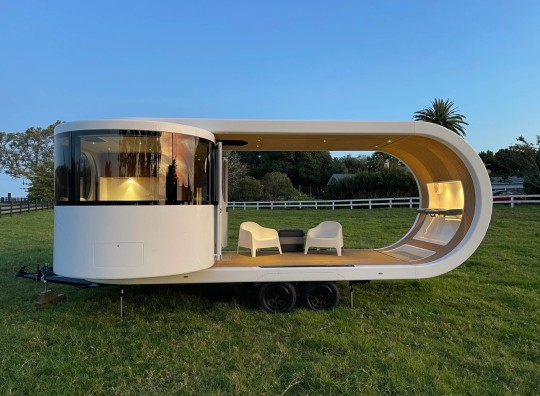







Romotow’s T8,
This ambitious concept was created on paper in 2012 as a futuristic idea, almost unattainable at that time. However, six years later, in 2018, the first renders were revealed, and today, this promising concept is down on its way to the market, with a design that stayed as aerodynamic and special as the initial sketches.
It needs only some seconds for the sleek rotatable trailer to transform into a glamping RV. With an automatic hydraulic mechanism, the inner section of the camper rotates 90 degrees and uncovers an L-shaped scheme.
The main cabin measures around nine meters, while the revealed deck extends the total floor space by 70%. The U-shaped wall accommodates a fold-down table or bench seat, enhancing the mobile living experience.
#art#design#travels#glamping#camping#romotow#T8#concept#usb flash drive#sustainability#eco-friendly#solar panels#RV#hydraulic#luxurylifestyle
379 notes
·
View notes
